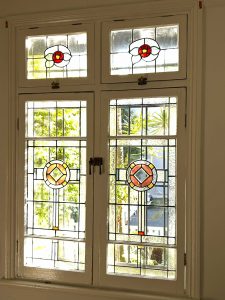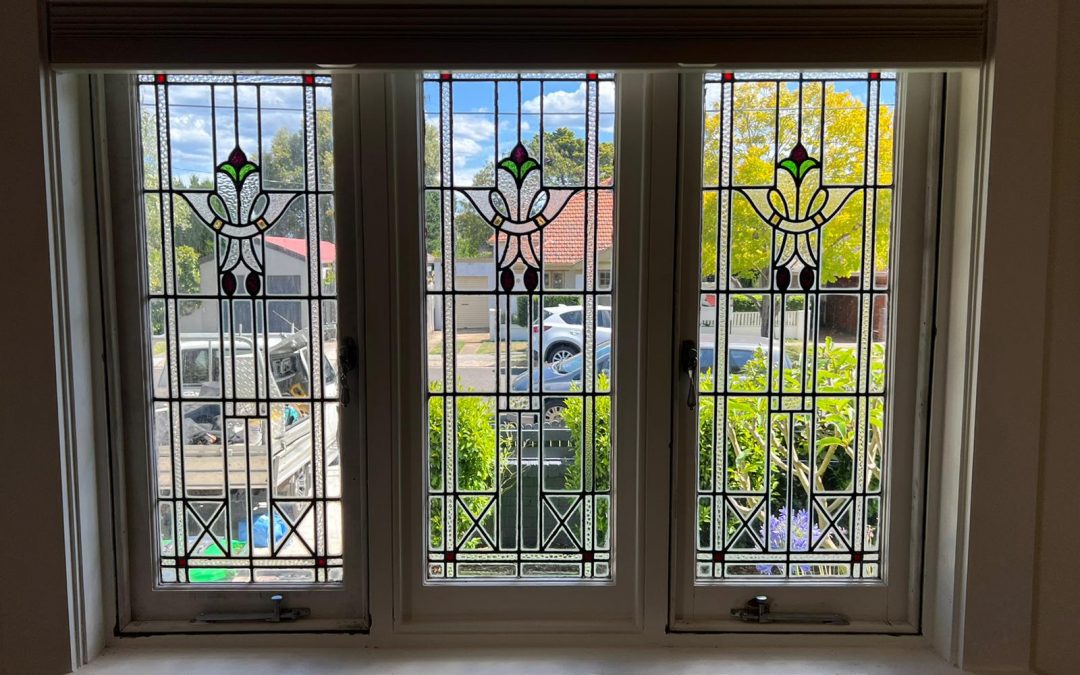The art of lead light windows, an early predecessor of stained glass, holds a rich history dating back to ancient times. As a visual testament to human creativity and spiritual expression, leadlight windows have played a crucial role in the cultural and religious narratives of various civilizations. In this exploration, we will delve into the transition of leadlight windows into the art during the 4th century, and the subsequent proliferation of these luminous works.
Leadlight History: A Look Back In Time
The history of lead light windows in Australia is a journey through the evolution of architectural design and artistic expression. These exquisite windows made their debut during the colonial period, and European settlers introduced the tradition of leadlight window making. The Victorian and Federation eras witnessed a surge in their production, with lead light windows becoming integral to Australian homes, showcasing styles ranging from Victorian Gothic to Federation Queen Anne.
The influence of design movements like Arts and Crafts, Art Nouveau, and Art Deco added further intricacy and innovation to leadlight window designs. In ecclesiastical buildings, lead light windows became not only decorative elements but also a means of illustrating religious narratives. Today, there is a modern revival of this craft, with contemporary designers blending traditional craftsmanship with innovative aesthetics, ensuring that lead light windows remain an enduring part of Australian architecture.
The history of lead light windows in Australia reflects the country’s commitment to preserving architectural heritage and artistic expression. These windows continue to be cherished and protected, whether in historic homes, churches, or public buildings, and their beauty and craftsmanship contribute to Australia’s architectural and cultural legacy. The legacy of lead light windows serves as a bridge between the past and the present, embodying the enduring appreciation for this exquisite art form in Australian architecture.
The Difference Between Leadlight and Stained Glass
Leadlight and stained glass are two distinct art forms, both utilizing colored glass to create visually stunning and luminous effects. While they share similarities, there are significant differences between the two that set them apart.
The differences between leadlight and stained glass windows are significant and encompass their composition, design complexity, settings and usage, craftsmanship, and aesthetic effects.
Composition
Lead light windows consist of smaller individual pieces of colored or clear glass held together by narrow lead cames. Stained glass windows use larger glass panels, held together by lead cames or copper foil, and can be highly detailed.
Design and Patterns
Leadlight windows feature simpler, more geometric designs due to the limitations of lead cames. Stained glass windows are known for intricate and highly detailed designs, often featuring complex narratives and a wide range of colors.
Settings and Usage
Lead light windows are commonly used in residential homes for doors, windows, and architectural features, offering aesthetic appeal and privacy. Stained glass windows are found in religious settings, such as churches and cathedrals, serving both artistic and religious purposes.
Craftsmanship and Technique
Crafting leadlight windows involves skilled artisans who cut and shape individual glass panes, securing them with lead cames. Stained glass windows also require expert craftsmanship, using larger glass panels and lead cames or copper foil to hold them in place.
Aesthetic and Lighting Effects
Lead light windows emphasize the interplay of colored and clear glass within geometric patterns, providing filtered illumination and moderate privacy. Stained glass windows create more dramatic and intricate lighting effects due to larger glass panels, with a focus on storytelling capacity and captivating light diffusion.
These differences highlight the unique characteristics and applications of leadlight and stained glass windows, both celebrated for their contribution to the beauty and luminosity of the spaces they adorn.

The Process: Well-crafted Work of Art
The process of creating leadlight windows is a highly skilled and intricate craft that combines artistic vision with precise craftsmanship. Here is a comprehensive overview of the leadlight making process:
1. Design and Planning
The process begins with a detailed design. The artist or designer sketches the leadlight pattern, considering the size, shape, and placement of each glass piece. The design may incorporate both colored and clear glass to achieve the desired aesthetic effect.
2. Glass Selection
Glass selection is a crucial step. Various types of glass are chosen for different effects, including colored, clear, textured, and sometimes even stained glass. The glass sheets are selected based on their color, texture, and transparency to align with the design.
3. Glass Cutting
Skilled artisans carefully cut the selected glass sheets into the desired shapes and sizes using various tools, including glass cutters. The precision of the cuts is essential to ensure that the pieces fit together seamlessly.
4. Glass Painting (if necessary)
In some cases, the glass pieces may be painted to add intricate details or shading. Glass paint is used to create subtle variations in color and enhance the overall design. The paint is applied and fired in a kiln to set it permanently.
5. Leading
This is a defining step in leadlight making. Narrow strips of lead called “lead cames” are used to create the framework for the glass pieces. The lead cames are typically H-shaped in cross-section, with a channel on either side to securely hold the glass. Artisans carefully cut and bend the lead cames to match the design and the contours of the glass pieces.
6. Assembly
The glass pieces are placed within the lead cames and held in position. This process requires meticulous attention to detail to ensure that each glass piece is snugly and securely fitted. The lead cames are positioned to create the desired pattern and define the design’s intricate lines.
7. Soldering
Soldering is used to join the intersecting lead cames. A soldering iron is applied to the lead cames, melting a solder (usually a lead-tin alloy) that fuses the joints. This creates a stable and secure structure, holding the glass pieces together.
8. Cementing
To reinforce the leadlight window and protect it from environmental factors, a cement mixture is applied over the lead cames. The cement is worked into the channels between the lead cames, providing structural stability and sealing the window.
9. Cleaning and Polishing
The leadlight window is thoroughly cleaned to remove excess cement and any marks. The glass is polished to a pristine shine, revealing the full brilliance of the colors and textures.
10. Installation
Once the leadlight window is completed, it can be installed in its intended location. This may involve placing it in a window frame, door, transom, or other architectural features.
The leadlight making process is a meticulous and labor-intensive craft, requiring a combination of artistic vision and technical skill. The resulting leadlight windows are cherished for their beauty, durability, and ability to enhance the aesthetics of architectural spaces while allowing the play of light and color.
Sydney’s Stained Glass Treasures: The Timeless Beauty of Leadlight Windows
Lead light windows in Australia, including Sydney, offer several essential benefits that enhance the aesthetics and functionality of homes and buildings. Here’s a comprehensive look at these advantages, along with some examples:
Aesthetic Appeal
-
- Lead light windows are renowned for their artistic and decorative qualities. They add a touch of elegance and charm to architectural spaces. The interplay of colored and clear glass in geometric or abstract patterns creates a visually captivating effect, enhancing the overall aesthetics of a room.
- Example: In a heritage-listed Victorian-era home in Sydney’s Paddington suburb, lead light windows featuring intricate floral designs enhance the living room’s aesthetic appeal. The interplay of light through these windows adds warmth and character to the space.
Natural Light and Privacy
-
- Leadlight windows allow natural light to filter through while providing a level of privacy. They offer a balance between illumination and seclusion, making them ideal for living spaces, bedrooms, and bathrooms.
- Example: In a modern apartment in Sydney’s CBD, leadlight windows in the bathroom allow natural light to enter while preserving privacy. The leadlight design complements the contemporary decor.
Heritage and Character
-
- Many heritage homes in Sydney feature leadlight windows, adding to the historical and architectural character of the properties. These windows are cherished for their contribution to the overall heritage appeal.
- Example: A Federation-style house in Sydney’s Mosman neighborhood boasts leadlight windows with Art Nouveau patterns, preserving the home’s early 20th-century character.
Customization
-
- Leadlight windows can be customized to match the architectural style and personal preferences. Homeowners and designers can work with artisans to create unique designs that suit the specific requirements of a space.
- Example: A beachfront property in Sydney’s Eastern Suburbs features leadlight windows designed to mimic the patterns of seashells, creating a beach-inspired aesthetic that complements the stunning coastal views.
Light Diffusion and Artistry
-
- The intricate designs and vivid colors of leadlight windows create stunning lighting effects. They can transform a room by diffusing light in captivating ways, making them not just functional but pieces of art.
- Example: A contemporary art gallery in Sydney’s Chippendale area incorporates leadlight windows with abstract geometric designs. The interplay of light and color adds a dynamic and artistic dimension to the gallery space.
Heritage Preservation
-
- Sydney places a strong emphasis on heritage conservation, and leadlight windows in older homes and buildings are often preserved and restored to maintain their historical and artistic value. This commitment to preservation ensures the enduring legacy of leadlight windows.
- Example: The restoration of lead light windows in a heritage-listed church in Sydney’s Rocks district showcases the city’s dedication to preserving its architectural heritage.
Leadlight windows in Sydney not only enhance the aesthetic appeal of homes and buildings but also contribute to the cultural and architectural heritage of this vibrant Australian city. They offer a timeless beauty and uniqueness that continue to be celebrated and embraced by homeowners, designers, and heritage preservationists alike.

Sydney’s Lead light Windows: A Luminous Legacy of Art and Architecture
In the heart of Sydney, the city that harmoniously blends modernity with its rich historical tapestry, leadlight windows stand as timeless witnesses to the passage of time. They are not merely decorative elements but living pieces of art, capturing the interplay of light and color and infusing spaces with elegance and character.
As Sydney’s skyline continues to evolve, these leadlight treasures remain steadfast, connecting the present with the past. Their intricate designs and vivid hues not only illuminate rooms but also our appreciation for artistry and craftsmanship. In a bustling metropolis, they provide a haven of heritage and tradition.
The next time you stroll through Sydney’s charming neighborhoods or visit one of its iconic buildings, take a moment to look up and admire the leadlight windows that grace its streets. Their beauty endures, reminding us that in the midst of progress, some things remain beautifully unchanged, eternally weaving the city’s history into its architectural fabric. Sydney’s leadlight windows, like a collection of timeless stories, continue to captivate, their radiance undiminished by the passing years.

